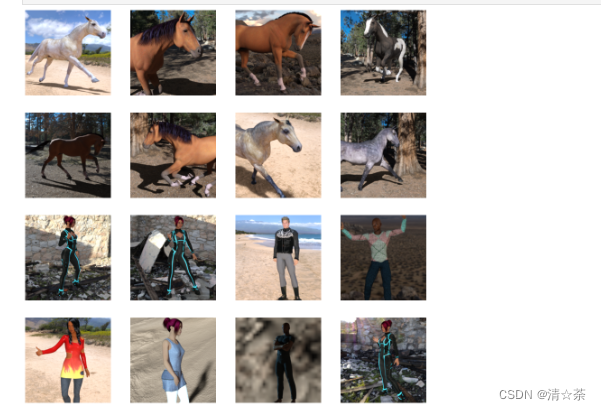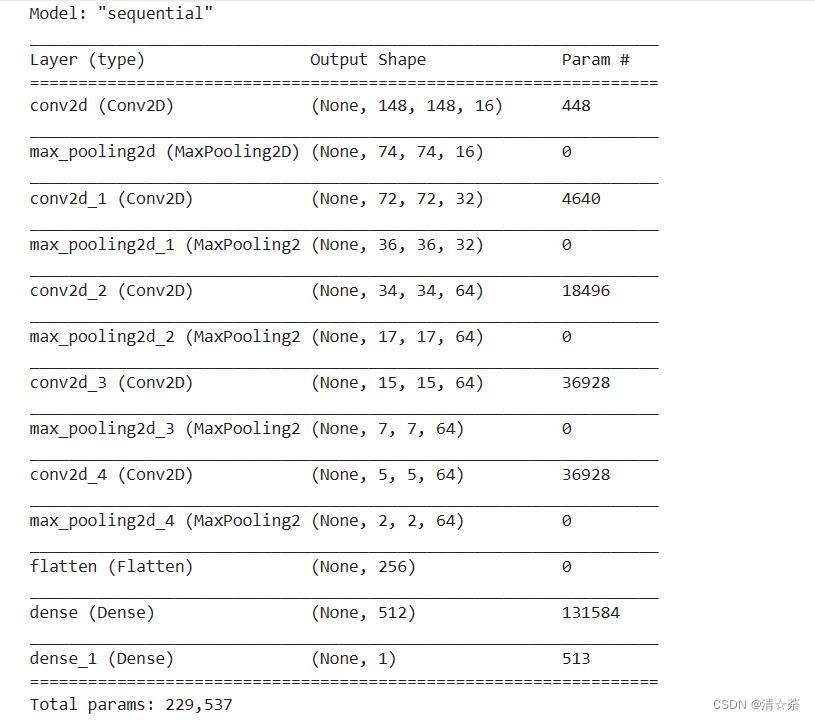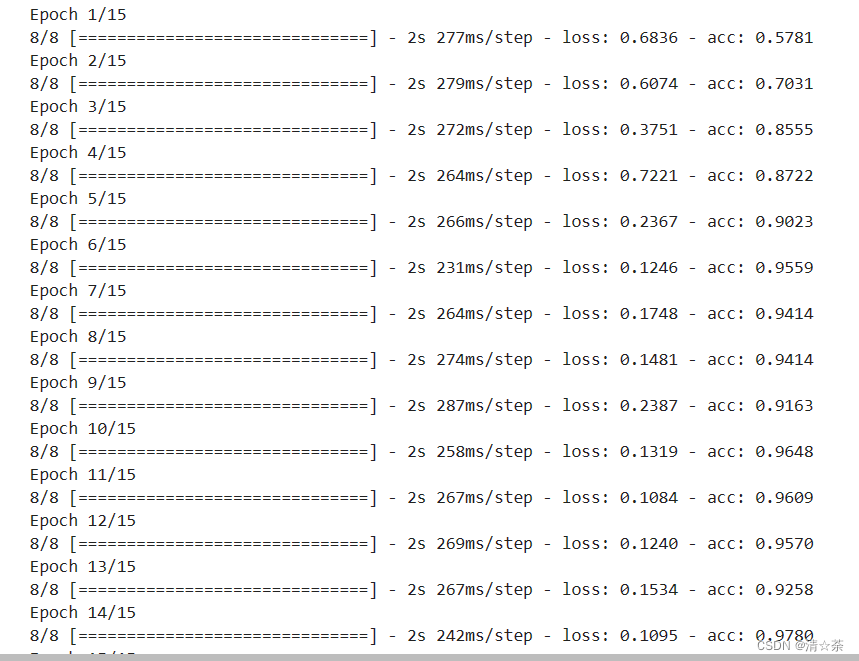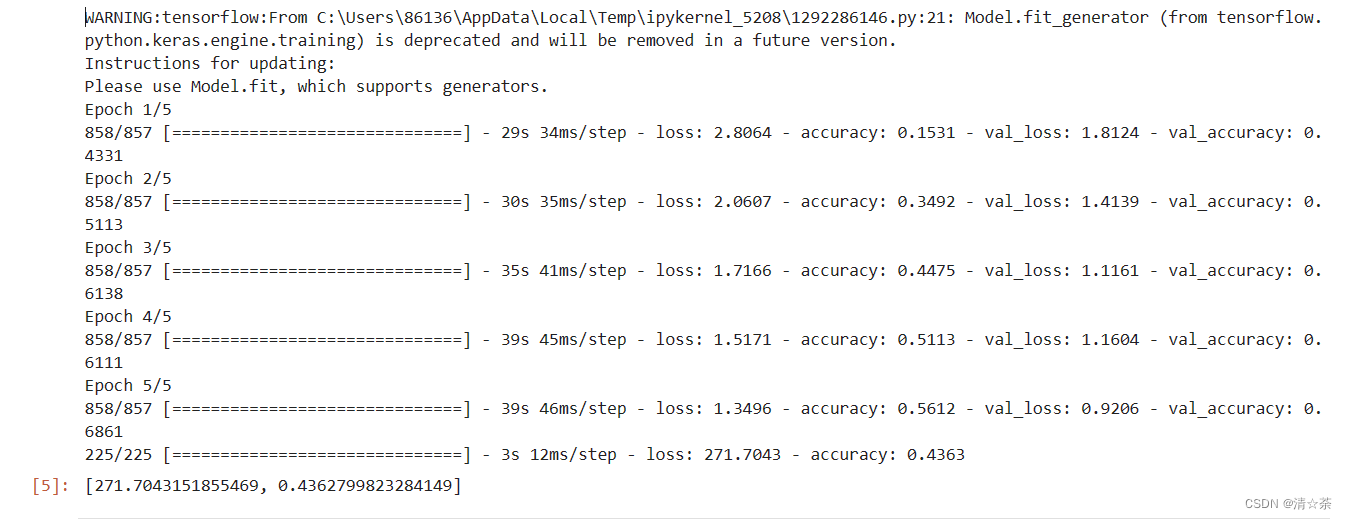1.机器视觉的应用。
比如医疗领域,图像分类典型算法介绍
实操练习:数据预处理、搭建模型、调整参数。
学习深度学习的卷积神经网络。
狗与猫的分类、人与马的分类、手写体的分类
2.训练狗猫识别的卷积神经网络代码实现:
对狗和猫两种数据进行区分。
#调用程序里面常用的一些库,
import os #os是文件操作的库
import zipfile #zip file主要是文件解压相关的一些库
import random #random就是随机数发生器的库
import tensorflow as tf #调用tensorflow深度学习的网络模型
from tensorflow.keras.optimizers import RMSprop #RMSPROP深度学习的优化算法
from tensorflow.keras.preprocessing.image import ImageDataGenerator #图进行预处理时调用ImageDataFenerator函数
from shutil import copyfile #copyfile是对文件进行复制的一些库
# If the URL doesn't work, visit https://www.microsoft.com/en-us/download/confirmation.aspx?id=54765
# And right click on the 'Download Manually' link to get a new URL to the dataset。下载训练集链接,把文件存到tmp中。
# Note: This is a very large dataset and will take time to download
#wget命令linux进行下载,但是windows操作系统只需要用链接进行下载
#!wget --no-check-certificate \
# "https://download.microsoft.com/download/3/E/1/3E1C3F21-ECDB-4869-8368-6DEBA77B919F/kagglecatsanddogs_3367a.zip" \
# -O "/tmp/cats-and-dogs.zip"
#数据准备
local_zip = '/tmp/cats-and-dogs.zip'
zip_ref = zipfile.ZipFile(local_zip, 'r') #调用ZipFile函数进行解压数据集
zip_ref.extractall('/tmp') #解压到tmp文件中
zip_ref.close()
print(len(os.listdir('/tmp/PetImages/Cat/'))) #os.listdir方法查看tmp中文件,len函数表示文件的个数
print(len(os.listdir('/tmp/PetImages/Dog/')))
# Expected Output:
# 12501
# 12501
#把狗猫的数据分开,狗的数据放在testing文件夹里,
#mkdir创建文件目录,创建狗猫的测试数据和训练数据。
try:
os.mkdir('/tmp/cats-v-dogs')
os.mkdir('/tmp/cats-v-dogs/training')
os.mkdir('/tmp/cats-v-dogs/testing')
os.mkdir('/tmp/cats-v-dogs/training/cats')
os.mkdir('/tmp/cats-v-dogs/training/dogs')
os.mkdir('/tmp/cats-v-dogs/testing/cats')
os.mkdir('/tmp/cats-v-dogs/testing/dogs')
except OSError:
pass
#把解压的数据进行分割,分割成训练集和测试集。
import os
import shutil
#定义一个函数,split_data分割数据,把解压后的样本集,那把它切分成训练集training和testing sample。随机划分读进来。
def split_data(SOURCE, TRAINING, TESTING, SPLIT_SIZE):#split_size是切分的尺寸
files = []
for filename in os.listdir(SOURCE):#把样本集解压的文件一个个读出来放到file文件加里。
file = SOURCE + filename
if os.path.getsize(file) > 0:#判断文件大小,>0,把文件名读进去,追加到我们列表中。有效的图片
files.append(filename)
else:#如果不是,则报文件大小为0
print(filename + " is zero length, so ignoring.")
training_length = int(len(files) * SPLIT_SIZE)#读进来以后会调用split_size(0函数,如果这个函数参数是0.9,则是抽出90%的比例,把它划分到训练集里面进行训练。
testing_length = int(len(files) - training_length)#测试样本就是总的样本文件减去刚抽出的测试样本集。
shuffled_set = random.sample(files, len(files))#打乱文件顺序,random进行随机采样。
training_set = shuffled_set[0:training_length]#训练样本集变成打乱以后样本集
testing_set = shuffled_set[-testing_length:]#剩下的做为测试样本集。
for filename in training_set:#读取训练样本集的
this_file = SOURCE + filename#source是原来存放猫狗数据的原路径,加上文件名,就是要读的文件的路径。
destination = TRAINING + filename
copyfile(this_file, destination)#copyfile的命令可以把它读进来,读到训练样本集中,读到以后放到destination。实际上就是训练样本集一个个读进来,读进来读到training_length的长度。
for filename in testing_set:#读取测试样本集的文件
this_file = SOURCE + filename
destination = TESTING + filename
copyfile(this_file, destination)
#把训练样本、测试样本放在training这个子目录下。
CAT_SOURCE_DIR = "/tmp/PetImages/Cat/"#猫的数据
TRAINING_CATS_DIR = "/tmp/cats-v-dogs/training/cats/"#猫的训练样本集
TESTING_CATS_DIR = "/tmp/cats-v-dogs/testing/cats/"#猫的测试样本集
DOG_SOURCE_DIR = "/tmp/PetImages/Dog/"#狗的数据
TRAINING_DOGS_DIR = "/tmp/cats-v-dogs/training/dogs/"
TESTING_DOGS_DIR = "/tmp/cats-v-dogs/testing/dogs/"
#creat_dir命令产生路径,实际上就是前面样本集的路径,通过file_dir命令。
def create_dir(file_dir):
if os.path.exists(file_dir): #如果文件路径存在,打印true
print('true')
#os.rmdir(file_dir)
shutil.rmtree(file_dir)#删除再建立
os.makedirs(file_dir)
else:
os.makedirs(file_dir)
#调用函数,通过函数名(参数),生成四个子目录
create_dir(TRAINING_CATS_DIR)
create_dir(TESTING_CATS_DIR)
create_dir(TRAINING_DOGS_DIR)
create_dir(TESTING_CATS_DIR)
#把解压后的数据集进行切分,分割比例定为0.9
split_size = .9
#调用split_data函数,主要功能把猫的数据和狗的数据分别地把它切分层训练集和测试集,切分比例90%,就是训练样本90%,测试样本10%
split_data(CAT_SOURCE_DIR, TRAINING_CATS_DIR, TESTING_CATS_DIR, split_size)
split_data(DOG_SOURCE_DIR, TRAINING_DOGS_DIR, TESTING_DOGS_DIR, split_size)
# Expected output
# 666.jpg is zero length, so ignoring
# 11702.jpg is zero length, so ignoring
#打印样本进行切分以后每个文件夹文件的个数
print(len(os.listdir('/tmp/cats-v-dogs/training/cats/')))
print(len(os.listdir('/tmp/cats-v-dogs/training/dogs/')))
print(len(os.listdir('/tmp/cats-v-dogs/testing/cats/')))
print(len(os.listdir('/tmp/cats-v-dogs/testing/dogs/')))
# Expected output:
# 11250
# 11250
# 1250
# 1250
#搭建卷积网络,进行训练。调用了keras库中的model,三对卷积最大池化,
#参数16,32,64,512,1表示通道,随着隐层的加深,通道数量逐步增加。
model = tf.keras.models.Sequential([#sequential表示每一行表示一层,层与层之间都是顺序相连。
tf.keras.layers.Conv2D(16, (3, 3), activation='relu', input_shape=(150, 150, 3)),#(3,3)表示卷积层的大小,relu是激活函数。输入层的输出就是150*150像素的三个通道。
tf.keras.layers.MaxPooling2D(2, 2),#输出层的神经元为一个神经元,二分类问题,要么是狗要么是猫。
tf.keras.layers.Conv2D(32, (3, 3), activation='relu'),
tf.keras.layers.MaxPooling2D(2, 2),
tf.keras.layers.Conv2D(64, (3, 3), activation='relu'),
tf.keras.layers.MaxPooling2D(2, 2),
tf.keras.layers.Flatten(),#第三对最大池化层flatten拉直。
tf.keras.layers.Dense(512, activation='relu'),#接一个全链接的隐层,用的relu函数
tf.keras.layers.Dense(1, activation='sigmoid')#然后再接到输出层,用到sigmoid函数
])
model.compile(optimizer=RMSprop(lr=0.001), loss='binary_crossentropy', metrics=['acc'])#学习步长是0.001,在梯度下降法训练网络过程中使用RMSprop修改学习步长。函数的损失函数用了二元交叉熵,网路性能的度量使用准确度。
#对数据进行预处理,ImageDataGenerator函数做规划,
TRAINING_DIR = "/tmp/cats-v-dogs/training/"
train_datagen = ImageDataGenerator(rescale=1.0/255.)#输入到输入层进行规划1/255,每个像素的编码都可以装成0~1之间的数值。
train_generator = train_datagen.flow_from_directory(TRAINING_DIR,
batch_size=100,#是epochs要循环的轮次
class_mode='binary',
target_size=(150, 150))
#对测试样本集做规划。
VALIDATION_DIR = "/tmp/cats-v-dogs/testing/"
validation_datagen = ImageDataGenerator(rescale=1.0/255.)
validation_generator = validation_datagen.flow_from_directory(VALIDATION_DIR,
batch_size=100,
class_mode='binary',
target_size=(150, 150))
# Expected Output:
# Found 22498 images belonging to 2 classes.
# Found 2500 images belonging to 2 classes.
#对网络进行训练,调用了model对象的fit_generator,fit就是拟合
# Note that this may take some time.
history = model.fit_generator(train_generator,
epochs=2,#说明拟合两轮,一轮就是所有的样本都要参加梯度下降,一批是对其中的100个样本进行训练。
verbose=1,#记录每次训练的日志
validation_data=validation_generator)
#查看训练结果,分析日志,
%matplotlib inline
import matplotlib.image as mpimg
import matplotlib.pyplot as plt
#-----------------------------------------------------------
# Retrieve a list of list results on training and test data
# sets for each training epoch
#-----------------------------------------------------------
#从日志中得到训练样本的准确度、测试样本的准确度以及损失函数
acc=history.history['acc']
val_acc=history.history['val_acc']
#loss就是从history把损失函数也计算出来,包括训练样本的损失函数和测试样本的损失函数。
loss=history.history['loss']
val_loss=history.history['val_loss']
epochs=range(len(acc)) # Get number of epochs
#------------------------------------------------
# Plot training and validation accuracy per epoch
#------------------------------------------------
#输出成一个散点图,调用matplotlib中的plot,横坐标是epochs,,纵坐标是训练精度,两条线,输出两个图,分别值准确度和loss,红线是训练样本,蓝线是测试样本。
plt.plot(epochs, acc, 'r', "Training Accuracy")
plt.plot(epochs, val_acc, 'b', "Validation Accuracy")
plt.title('Training and validation accuracy')
plt.figure()
#------------------------------------------------
# Plot training and validation loss per epoch
#------------------------------------------------
plt.plot(epochs, loss, 'r', "Training Loss")
plt.plot(epochs, val_loss, 'b', "Validation Loss")
plt.figure()
# Desired output. Charts with training and validation metrics. No crash :)
# Here's a codeblock just for fun. You should be able to upload an image here
# and have it classified without crashing
#功能:输入新的图片进行预处理以后输入到训练好的网络,网络就会预测图片到底是狗还是猫,
import numpy as np
from google.colab import files
from keras.preprocessing import image
uploaded = files.upload()
for fn in uploaded.keys():
# predicting images
path = '/content/' + fn
img = image.load_img(path, target_size=(150, 150))#加载文件名路径,图像大小为150*150像素
x = image.img_to_array(img)#把编码列表转成数组的形式
x = np.expand_dims(x, axis=0)#把多维数组通过expand_dims命令拉直成相应的向量。
images = np.vstack([x])#vstack按照水平方向把expand_dim各个通道的数据连起来构成一个长向量。
classes = model.predict(images, batch_size=10)#模型预测运行输出对应的类别。
print(classes[0])
if classes[0]>0.5:#类别的可能性,输出层>0.5表示图片是狗,否则是猫
print(fn + " is a dog")
else:
print(fn + " is a cat")
人马分类案例:
下载链接:https://storage.googleapis.com/laurencemoroney-blog.appspot.com/horse-or-human.zip
下面的python代码将使用OS库来调用文件系统,并使用zipfile库来解压数据。
import os
import zipfile
local_zip = '/tmp/horse-or-human.zip'
zip_ref = zipfile.ZipFile(local_zip, 'r')
zip_ref.extractall('/tmp/horse-or-human')
zip_ref.close()
Zip文件的内容会被解压到目录/tmp/horse-or-human,而该目录下又分别包含horses和humans子目录。
简而言之:训练集就是用来告诉神经网络模型 “这就是马的样子”、"这就是人的样子 "等数据。
这里需要注意的是,我们并没有明确地将图像标注为马或人。如果还记得之前的手写数字例子,它的训练数据已经标注了 “这是一个1”,"这是一个7 "等等。 稍后,我们使用一个叫做ImageGenerator的类–用它从子目录中读取图像,并根据子目录的名称自动给图像贴上标签。所以,会有一个 "训练 "目录,其中包含一个 "马匹 "目录和一个 "人类 "目录。ImageGenerator将为你适当地标注图片,从而减少一个编码步骤。(不仅编程上更方便,而且可以避免一次性把所有训练数据载入内存,而导致内存不够等问题。)
让我们分别定义这些目录。
# Directory with our training horse pictures
train_horse_dir = os.path.join('/tmp/horse-or-human/horses')
# Directory with our training human pictures
train_human_dir = os.path.join('/tmp/horse-or-human/humans')#生成两个文件夹存储马和人的数据
现在,让我们看看 "马 "和 "人 "训练目录中的文件名是什么样的。
train_horse_names = os.listdir(train_horse_dir)
print(train_horse_names[:10])
train_human_names = os.listdir(train_human_dir)
print(train_human_names[:10])#从两个子文件读10个文件名
结果:
[‘horse39-1.png’, ‘horse47-6.png’, ‘horse12-1.png’, ‘horse23-7.png’, ‘horse11-0.png’, ‘horse50-8.png’, ‘horse38-5.png’, ‘horse42-3.png’, ‘horse29-5.png’, ‘horse36-6.png’]
[‘human09-00.png’, ‘human09-14.png’, ‘human11-11.png’, ‘human04-14.png’, ‘human14-14.png’, ‘human07-03.png’, ‘human06-04.png’, ‘human09-29.png’, ‘human08-03.png’, ‘human14-16.png’]
我们来看看目录中马和人的图片总数。
#统计训练样本集中马和人的图片总数。
print('total training horse images:', len(os.listdir(train_horse_dir)))
print('total training human images:', len(os.listdir(train_human_dir)))
结果:
total training horse images: 500
total training human images: 527
现在我们来看看几张图片,以便对它们的样子有个直观感受。首先,配置matplot参数。
#把马和人的数据显示出来
%matplotlib inline
import matplotlib.pyplot as plt
import matplotlib.image as mpimg
#显示4行4列,16个图片
# Parameters for our graph; we'll output images in a 4x4 configuration
nrows = 4
ncols = 4
# Index for iterating over images
pic_index = 0#定义图的索引
接下来,显示一批8张马和8张人的图片。每次重新运行单元格,都会看到一个新的批次(另外8张马和8张人)。定义图的尺寸
# Set up matplotlib fig, and size it to fit 4x4 pics
fig = plt.gcf()
fig.set_size_inches(ncols * 4, nrows * 4)
pic_index += 8 #图的索引加8
next_horse_pix = [os.path.join(train_horse_dir, fname)
for fname in train_horse_names[pic_index-8:pic_index]]#把马的名字读进来,读的是索引从马的子目录下是0~7的前八张图像,复制给前面的变量
next_human_pix = [os.path.join(train_human_dir, fname)
for fname in train_human_names[pic_index-8:pic_index]]
for i, img_path in enumerate(next_horse_pix+next_human_pix):#使用for循环把16张图片显示出来,使用了枚举方法
# Set up subplot; subplot indices start at 1
sp = plt.subplot(nrows, ncols, i + 1)#四行四类,i+1为图的位置
sp.axis('Off') # Don't show axes (or gridlines)#图不显示坐标
img = mpimg.imread(img_path)#imread表示把图读进来
plt.imshow(img)
plt.show()

从零开始建立一个小型模型
让我们开始定义模型:
第一步是导入tensorflow
import tensorflow as tf
然后,像前面的例子一样添加卷积层,并将最终结果扁平化,以输送到全连接的层去。
最后我们添加全连接层。
需要注意的是,由于我们面对的是一个两类分类问题,即二类分类问题,所以我们会用sigmoid激活函数作为模型的最后一层,这样我们网络的输出将是一个介于0和1之间的有理数,即当前图像是1类(而不是0类)的概率。
model = tf.keras.models.Sequential([
# Note the input shape is the desired size of the image 300x300 with 3 bytes color
# This is the first convolution
#
tf.keras.layers.Conv2D(16, (3,3), activation='relu', input_shape=(150, 150, 3)),
tf.keras.layers.MaxPooling2D(2, 2),
# The second convolution
tf.keras.layers.Conv2D(32, (3,3), activation='relu'),
tf.keras.layers.MaxPooling2D(2,2),
# The third convolution
tf.keras.layers.Conv2D(64, (3,3), activation='relu'),
tf.keras.layers.MaxPooling2D(2,2),
# The fourth convolution
tf.keras.layers.Conv2D(64, (3,3), activation='relu'),
tf.keras.layers.MaxPooling2D(2,2),
# The fifth convolution
tf.keras.layers.Conv2D(64, (3,3), activation='relu'),
tf.keras.layers.MaxPooling2D(2,2),
# Flatten the results to feed into a DNN
tf.keras.layers.Flatten(),
# 512 neuron hidden layer
tf.keras.layers.Dense(512, activation='relu'),
# Only 1 output neuron. It will contain a value from 0-1 where 0 for 1 class ('horses') and 1 for the other ('humans')
tf.keras.layers.Dense(1, activation='sigmoid')
])
调用model.summary()方法打印出神经元网络模型的结构信息
model.summary()
结果:

"输出形状 "一栏显示了特征图尺寸在每个层中是如何演变的。卷积层由于边框关系而使特征图的尺寸减小了一些,而每个池化层则将输出尺寸减半。
接下来,我们将配置模型训练的参数。我们将用 "binary_crossentropy(二元交叉熵)"衡量损失,因为这是一个二元分类问题,最终的激活函数是一个sigmoid。关于损失度量的复习,请参见机器学习速成班。我们将使用rmsprop作为优化器,学习率为0.001。在训练过程中,我们将希望监控分类精度。
NOTE:我们将使用学习率为0.001的rmsprop优化器。在这种情况下,使用RMSprop优化算法比随机梯度下降(SGD)更可取,因为RMSprop可以为我们自动调整学习率。(其他优化器,如Adam和Adagrad,也会在训练过程中自动调整学习率,在这里也同样有效。)
from tensorflow.keras.optimizers import RMSprop
model.compile(loss='binary_crossentropy',
optimizer=RMSprop(lr=0.001),
metrics=['acc'])
数据预处理
让我们设置训练数据生成器(ImageDataGenerator),它将读取源文件夹中的图片,将它们转换为float32多维数组,并将图像数据(连同它们的标签)反馈给神经元网络。总共需要两个生成器,有用于产生训练图像,一个用于产生验证图像。生成器将产生一批大小为300x300的图像及其标签(0或1)。
前面的课中我们已经知道如何对训练数据做归一化,进入神经网络的数据通常应该以某种方式进行归一化,以使其更容易被网络处理。在这个例子中,我们将通过将像素值归一化到[0, 1]范围内(最初所有的值都在[0, 255]范围内)来对图像进行预处理。
在Keras中,可以通过keras.preprocessing.image.ImageDataGenerator类使用rescale参数来实现归一化。通过ImageDataGenerator类的.flow(data, labels)或.flow_from_directory(directory),可以创建生成器。然后,这些生成器可以作为输入Keras方法的参数,如fit_generator、evaluate_generator和predict_generator都可接收生成器实例为参数。
from tensorflow.keras.preprocessing.image import ImageDataGenerator
# All images will be rescaled by 1./255
train_datagen = ImageDataGenerator(rescale=1/255)
# Flow training images in batches of 128 using train_datagen generator
train_generator = train_datagen.flow_from_directory(
'/tmp/horse-or-human/', # This is the source directory for training images
target_size=(150, 150), # All images will be resized to 150x150
batch_size=32, #128
# Since we use binary_crossentropy loss, we need binary labels
class_mode='binary')
结果:Found 1027 images belonging to 2 classes.
#训练
让我们训练15个epochs–这可能需要几分钟的时间完成运行。
请注意每次训练后的数值。
损失和准确率是训练进展的重要指标。模型对训练数据的类别进行预测,然后根据已知标签进行评估,计算准确率。准确率是指正确预测的比例。
history = model.fit(
train_generator,
steps_per_epoch=8,
epochs=15,
verbose=1)
训练结果:

运行模型
接下来,看看使用模型进行实际预测。这段代码将允许你从文件系统中选择1个或多个文件,然后它将上传它们,并通过模型判断给出图像是马还是人。
import numpy as np
from google.colab import files
from tensorflow.keras.preprocessing import image
uploaded = files.upload()
for fn in uploaded.keys():
# predicting images
path = '/content/' + fn
img = image.load_img(path, target_size=(300, 300))
x = image.img_to_array(img)#把编码转成数组
x = np.expand_dims(x, axis=0)#水平方向转成向量
images = np.vstack([x])#把三个向量连起来,展成一个
classes = model.predict(images, batch_size=10)
print(classes[0])
if classes[0]>0.5:
print(fn + " is a human")
else:
print(fn + " is a horse")
报错:
ModuleNotFoundError: No module named ‘google-cloab’
解决方法:进入Anaconda Prompt中先输入conda activate textenv切换环境。
然后再下载:conda install -c conda-forge google-colab
如果执行出现C:\ProgramData\Anaconda3\envs\textenv\Lib\site-packages\google\colab__init__文件报错,直接把报错行代码注释掉。
将中间层的输出可视化
要想了解 convnet(卷积层)学到了什么样的特征,一个有趣的办法是将模型每个卷积层的输出当作图像可视化。
让我们从训练集中随机选取一张图像,然后将每一层的输出排列在一行里,生成一个汇总图。行中的每张图像都是一个特定过滤器输出的特征。每次运行下面这个单元的代码,就会随机显示一张图像的中间输出结果。
import numpy as np
import random
from tensorflow.keras.preprocessing.image import img_to_array, load_img
# Let's define a new Model that will take an image as input, and will output
# intermediate representations for all layers in the previous model after
# the first.
successive_outputs = [layer.output for layer in model.layers[1:]]
#visualization_model = Model(img_input, successive_outputs)
visualization_model = tf.keras.models.Model(inputs = model.input, outputs = successive_outputs)
# Let's prepare a random input image from the training set.
horse_img_files = [os.path.join(train_horse_dir, f) for f in train_horse_names]
human_img_files = [os.path.join(train_human_dir, f) for f in train_human_names]#从训练集中随机挑选数据
img_path = random.choice(horse_img_files + human_img_files)
img = load_img(img_path, target_size=(300, 300)) # this is a PIL image
x = img_to_array(img) # Numpy array with shape (150, 150, 3)#数据转成数组
x = x.reshape((1,) + x.shape) # Numpy array with shape (1, 150, 150, 3)
# Rescale by 1/255
x /= 255
# Let's run our image through our network, thus obtaining all
# intermediate representations for this image.
successive_feature_maps = visualization_model.predict(x)
# These are the names of the layers, so can have them as part of our plot
layer_names = [layer.name for layer in model.layers]
# Now let's display our representations
for layer_name, feature_map in zip(layer_names, successive_feature_maps):
if len(feature_map.shape) == 4:
# Just do this for the conv / maxpool layers, not the fully-connected layers
n_features = feature_map.shape[-1] # number of features in feature map
# The feature map has shape (1, size, size, n_features)
size = feature_map.shape[1]
# We will tile our images in this matrix
display_grid = np.zeros((size, size * n_features))
for i in range(n_features):
# Postprocess the feature to make it visually palatable
x = feature_map[0, :, :, i]
x -= x.mean()
x /= x.std()
x *= 64
x += 128
x = np.clip(x, 0, 255).astype('uint8')
# We'll tile each filter into this big horizontal grid
display_grid[:, i * size : (i + 1) * size] = x
# Display the grid
scale = 20. / n_features
plt.figure(figsize=(scale * n_features, scale))
plt.title(layer_name)
plt.grid(False)
plt.imshow(display_grid, aspect='auto', cmap='viridis')
从上面结果可以看出,图像每通过模型的一层,像素特征变得越来越抽象和紧凑。逐渐地,表征开始突出网络所关注的内容,它们显示出越来越少的像素被 “激活”;大多数被设置为零。这就是所谓的 “稀疏性”。表征稀疏性是深度学习的一个关键特征。
这些表征携带的图像原始像素的信息越来越少,但关于图像类别的信息却越来越精细。你可以把一个convnet(或一般的深度网络)看作是一个信息提炼管道。
清理:
运行以下单元格可以终止内核并释放内存资源。当计算资源不够时需要进行释放。
import os, signal
os.kill(os.getpid(), signal.SIGKILL)
调参
构造神经元网络模型时,一定会考虑需要几个卷积层?过滤器应该几个?全连接层需要几个神经元?
最先想到的肯定是手动修改那些参数,然后观察训练的效果(损失和准确度),从而判断参数的设置是否合理。但是那样很繁琐,因为参数组合会有很多,训练时间很长。再进一步,可以手动编写一些循环,通过遍历来搜索合适的参数。但是最好利用专门的框架来搜索参数,不太容易出错,效果也比前两种方法更好。
Kerastuner就是一个可以自动搜索模型训练参数的库。它的基本思路是在需要调整参数的地方插入一个特殊的对象(可指定参数范围),然后调用类似训练那样的search方法即可。
接下来首先准备训练数据和需要加载的库。
import os
from tensorflow.keras.preprocessing.image import ImageDataGenerator
from tensorflow.keras.optimizers import RMSprop
train_datagen = ImageDataGenerator(rescale=1/255)
validation_datagen = ImageDataGenerator(rescale=1/255)
train_generator = train_datagen.flow_from_directory('/tmp/horse-or-human/',
target_size=(150, 150),batch_size=32,class_mode='binary')
validation_generator = validation_datagen.flow_from_directory('/tmp/validation-horse-or-human/',
target_size=(150, 150), batch_size=32,class_mode='binary')
from kerastuner.tuners import Hyperband
from kerastuner.engine.hyperparameters import HyperParameters
import tensorflow as tf
接着创建HyperParameters对象,然后在模型中插入Choice、Int等调参用的对象。
hp=HyperParameters()
def build_model(hp):
model = tf.keras.models.Sequential()
model.add(tf.keras.layers.Conv2D(hp.Choice('num_filters_top_layer',values=[16,64],default=16), (3,3),
activation='relu', input_shape=(150, 150, 3)))
model.add(tf.keras.layers.MaxPooling2D(2, 2))
for i in range(hp.Int("num_conv_layers",1,3)):
model.add(tf.keras.layers.Conv2D(hp.Choice(f'num_filters_layer{i}',values=[16,64],default=16), (3,3), activation='relu'))
model.add(tf.keras.layers.MaxPooling2D(2,2))
model.add(tf.keras.layers.Flatten())
model.add(tf.keras.layers.Dense(hp.Int("hidden_units",128,512,step=32), activation='relu'))
model.add(tf.keras.layers.Dense(1, activation='sigmoid'))
model.compile(loss='binary_crossentropy',optimizer=RMSprop(lr=0.001),metrics=['acc'])
return model
然后创建Hyperband对象,这是Kerastuner支持的四种方法的其中一种,其优点是能较四童话第查找参数。具体资料可以到Kerastuner的网站获取。
最后调用search方法。
tuner=Hyperband(
build_model,
objective='val_acc',
max_epochs=10,
directory='horse_human_params',
hyperparameters=hp,
project_name='my_horse_human_project'
)
tuner.search(train_generator,epochs=10,validation_data=validation_generator)
搜索到最优参数后,可以通过下面的程序,用tuner对象提取最优参数构建神经元网络模型。并调用summary方法观察优化后的网络结构。
best_hps=tuner.get_best_hyperparameters(1)[0]
print(best_hps.values)
model=tuner.hypermodel.build(best_hps)
model.summary()
手写体识别案例:
import csv
import numpy as np
import tensorflow as tf
from tensorflow.keras.preprocessing.image import ImageDataGenerator
def get_data(filename):
with open(filename) as training_file:
csv_reader = csv.reader(training_file, delimiter=',')
first_line = True
temp_images = []
temp_labels = []
for row in csv_reader:
if first_line:
# print("Ignoring first line")
first_line = False
else:
temp_labels.append(row[0])
image_data = row[1:785]
image_data_as_array = np.array_split(image_data, 28)
temp_images.append(image_data_as_array)
images = np.array(temp_images).astype('float')
labels = np.array(temp_labels).astype('float')
return images, labels
training_images, training_labels = get_data('sign_mnist_train.csv')
testing_images, testing_labels = get_data('sign_mnist_test.csv')
print(training_images.shape)
print(training_labels.shape)
print(testing_images.shape)
print(testing_labels.shape)
(27455, 28, 28)
(27455,)
(7172, 28, 28)
(7172,)
training_images = np.expand_dims(training_images, axis=3)
testing_images = np.expand_dims(testing_images, axis=3)
train_datagen = ImageDataGenerator(
rescale=1. / 255,
rotation_range=40,
width_shift_range=0.2,
height_shift_range=0.2,
shear_range=0.2,
zoom_range=0.2,
horizontal_flip=True,
fill_mode='nearest')
validation_datagen = ImageDataGenerator(
rescale=1. / 255)
print(training_images.shape)
print(testing_images.shape)
(27455, 28, 28, 1)
(7172, 28, 28, 1)
model = tf.keras.models.Sequential([
tf.keras.layers.Conv2D(64, (3, 3), activation='relu', input_shape=(28, 28, 1)),
tf.keras.layers.MaxPooling2D(2, 2),
tf.keras.layers.Conv2D(64, (3, 3), activation='relu'),
tf.keras.layers.MaxPooling2D(2, 2),
tf.keras.layers.Flatten(),
tf.keras.layers.Dense(128, activation=tf.nn.relu),
tf.keras.layers.Dense(26, activation=tf.nn.softmax)])
# Before modification
# model.compile(optimizer = tf.train.AdamOptimizer(),
# loss = 'sparse_categorical_crossentropy',
# metrics=['accuracy'])
#
# After modification
model.compile(optimizer = tf.optimizers.Adam(),
loss = 'sparse_categorical_crossentropy',
metrics=['accuracy'])
history = model.fit_generator(train_datagen.flow(training_images, training_labels, batch_size=32),
steps_per_epoch=len(training_images) / 32,
epochs=5,
validation_data=validation_datagen.flow(testing_images, testing_labels, batch_size=32),
validation_steps=len(testing_images) / 32)
model.evaluate(testing_images, testing_labels)

import matplotlib.pyplot as plt
acc = history.history['acc']
val_acc = history.history['val_acc']
loss = history.history['loss']
val_loss = history.history['val_loss']
epochs = range(len(acc))
plt.plot(epochs, acc, 'r', label='Training accuracy')
plt.plot(epochs, val_acc, 'b', label='Validation accuracy')
plt.title('Training and validation accuracy')
plt.legend()
plt.figure()
plt.plot(epochs, loss, 'r', label='Training Loss')
plt.plot(epochs, val_loss, 'b', label='Validation Loss')
plt.title('Training and validation loss')
plt.legend()
plt.show()






















 被折叠的 条评论
为什么被折叠?
被折叠的 条评论
为什么被折叠?








